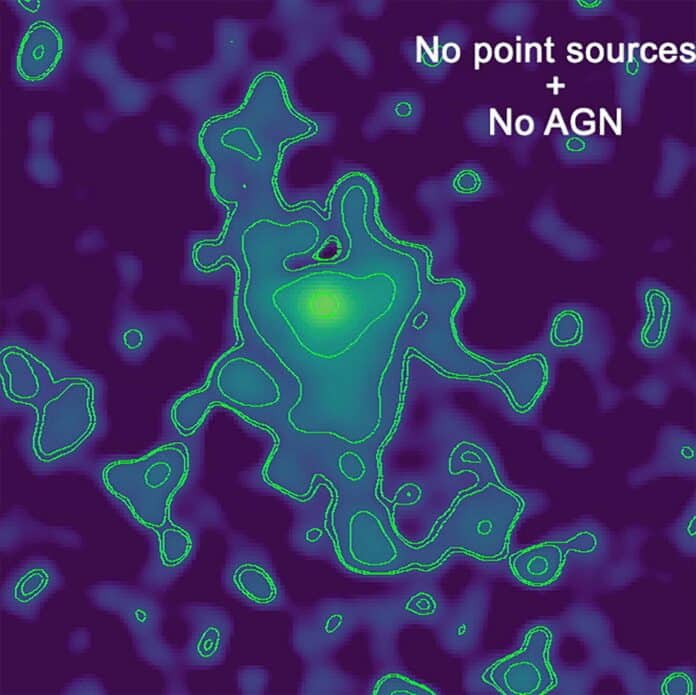Scientists at NASA’s Goddard Space Flight Center found X-ray activity revealing insights into galaxy evolution. They observed X-rays outlining large clouds of cold gas in the spiral galaxy NGC 4945. This gas seems to have burst out from the galaxy after its central supermassive black hole became active around 5 million years ago.
NGC 4945, situated about 13 million light-years away in the southern constellation Centaurus, is an active galaxy.
Active galaxies have exceptionally bright and variable centers powered by a supermassive black hole. This black hole heats a surrounding disk of gas and dust through gravitational and frictional forces. As the black hole consumes nearby material, it changes the emitted light from the disk. In the case of NGC 4945, like many active galaxies, the black hole and disk are surrounded by a dense cloud of dust known as a torus, which partially blocks the emitted light.
The cores of active galaxies, including NGC 4945, can produce jets of high-speed particles and generate powerful winds containing gas and dust.
NGC 4945 is an active galaxy and a starburst galaxy, meaning it forms stars at a much higher rate than our own Milky Way. Scientists estimate that NGC 4945 produces the equivalent mass of 18 stars like our Sun every year, nearly three times the rate of the Milky Way. Most of this star formation occurs in the galaxy’s center. Starburst events typically last between 10 and 100 million years, concluding when the raw materials needed to create new stars are depleted.
Scientists used a satellite to observe NGC 4945 and discovered a feature known as the iron K-alpha line in the data. This feature appears when extremely energetic X-ray light from the black hole’s disk interacts with cold gas located elsewhere in the galaxy. This gas has a temperature of approximately minus 400 degrees Fahrenheit or minus 200 degrees Celsius.
While the iron line is common in active galaxies, these observations challenged previous assumptions by revealing that it happens on scales much farther from the black hole than scientists previously thought.
Jenna Cann, a co-author and postdoctoral researcher at Goddard, said, “Chandra has mapped iron K-alpha in other galaxies. This one helped us study individual bright X-ray sources in the cloud to help us rule out other potential origins besides the black hole. But NGC 4945’s line extends so far from its center that we needed XMM-Newton’s wide field of view to see all of it.”
NGC 4945’s tilted orientation from our viewpoint allowed the XMM-Newton satellite to map the iron line’s extent along and above the galaxy’s plane. This mapping extended up to 32,000 and 16,000 light-years, respectively, which is ten times farther than previously observed iron lines.
The scientific team proposes that the cold gas emphasized by the iron line is a remnant of a particle jet originating from the central black hole about 5 million years ago. This jet likely angled into the galaxy, propelling a powerful wind that continues to push cold gas throughout the galaxy. This wind might have even triggered the current starburst event.
Ongoing observations of NGC 4945 will help scientists uncover additional ways in which the black hole influences the galaxy’s evolution. The same X-rays from the disk highlighting the cold gas might eventually dissipate it. Understanding this process could provide insights into how the activity around a galaxy’s black hole can impact and regulate its star formation.
Co-author Edmund Hodges-Kluck, an astrophysicist at Goddard, said, “There are a number of lines of evidence that indicate black holes play important roles in some galaxies in determining their star formation histories and their destinies. We study a lot of galaxies, like NGC 4945, because while the physics is pretty much the same from black hole to black hole, the impact they have on their galaxies varies widely. XMM-Newton helped us discover a galactic fossil we didn’t know to look for – but it’s likely just the first of many.”
The results are presented at the 243rd meeting of the American Astronomical Society in New Orleans on Jan. 11. A paper about the finding is now under review by The Astrophysical Journal. The work was made possible thanks to data collected by the ESA (European Space Agency) satellite XMM-Newton (X-ray Multi-Mirror Mission) with help from NASA’s Chandra X-ray Observatory.
